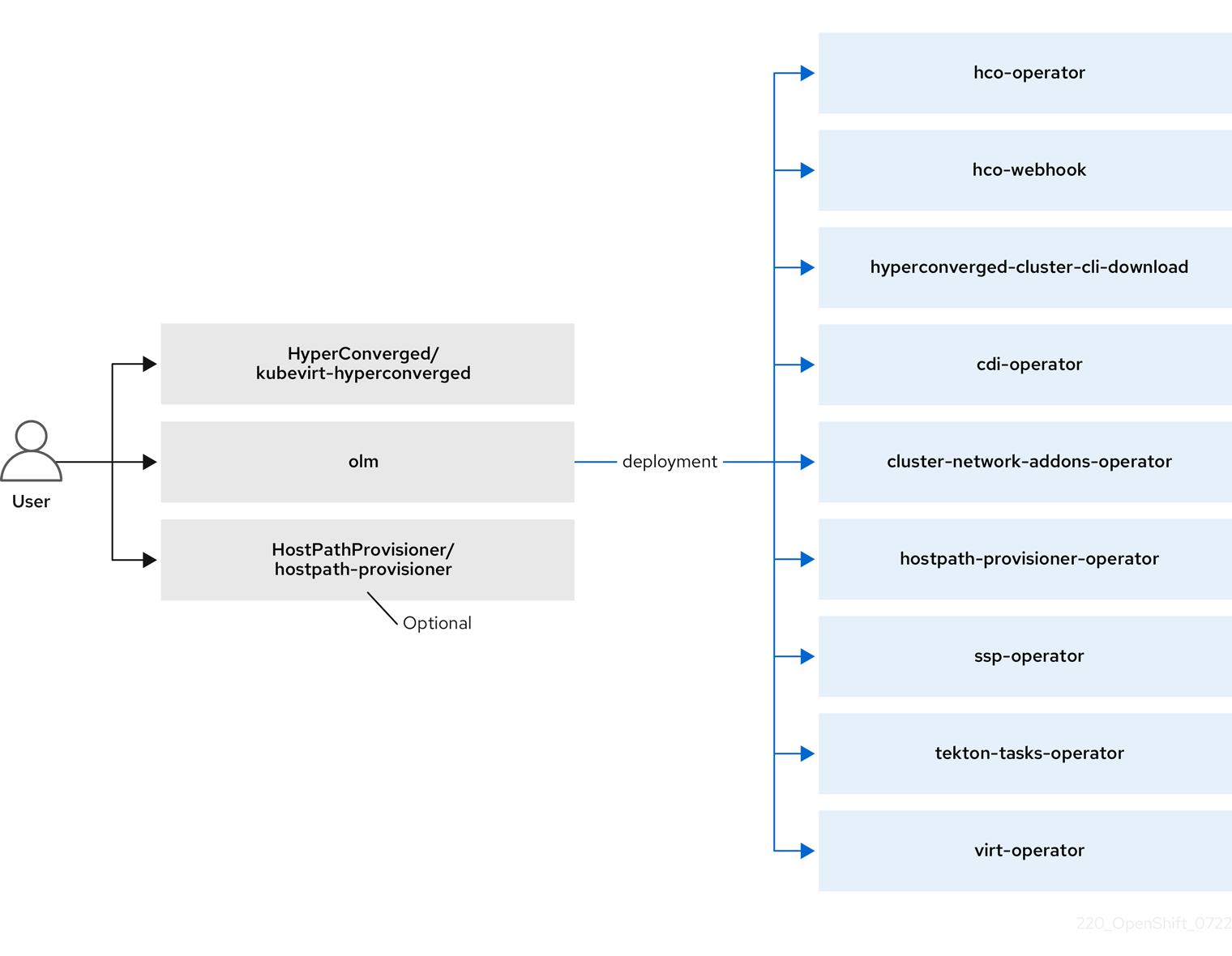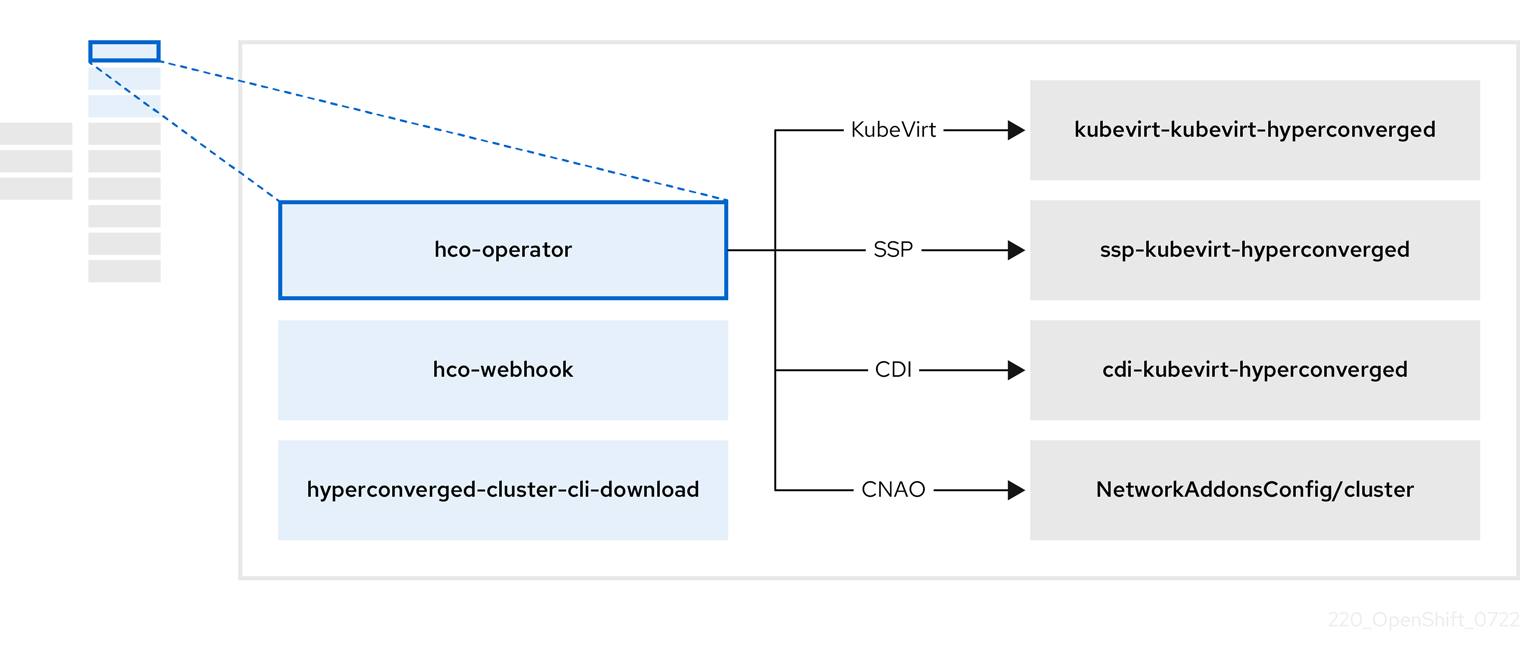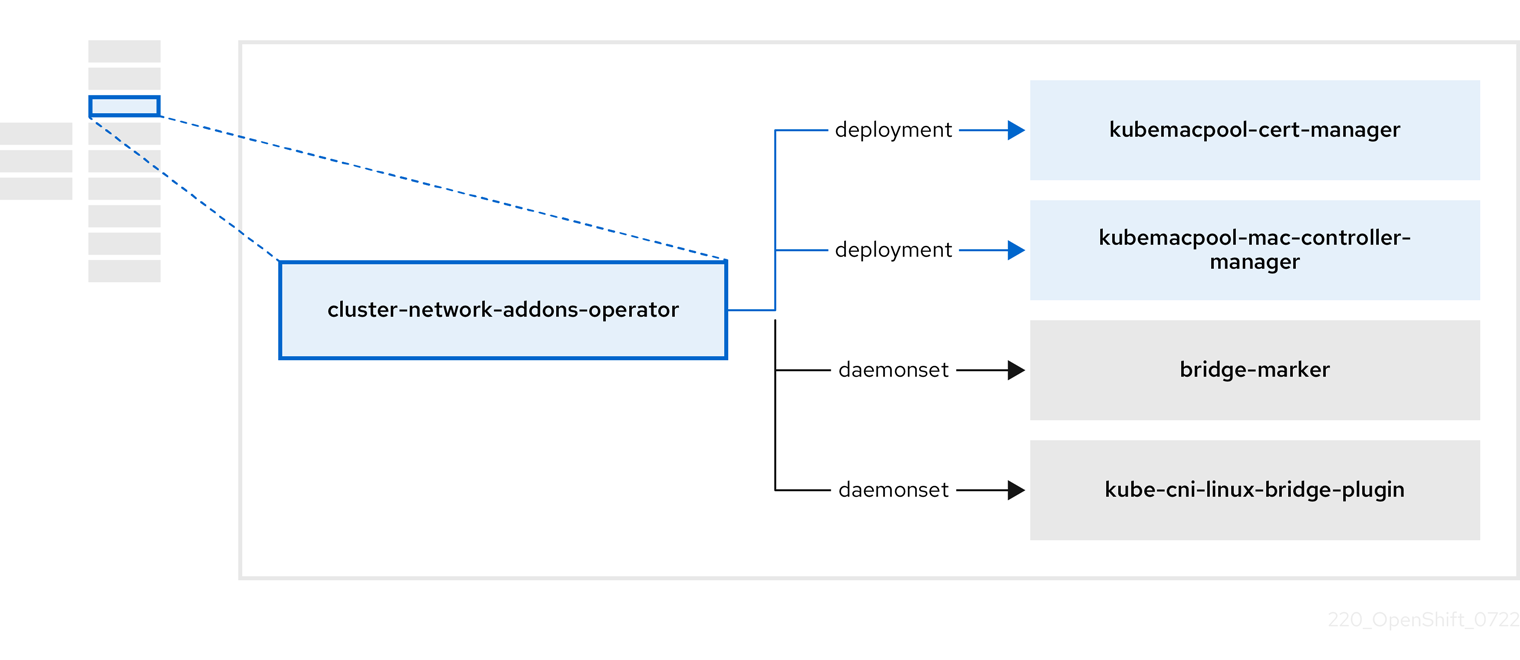This documentation is for a release that is no longer maintained
See documentation for the latest supported version 3 or the latest supported version 4.Chapter 2. OpenShift Virtualization architecture
Learn about OpenShift Virtualization architecture.
2.1. How OpenShift Virtualization architecture works
After you install OpenShift Virtualization, the Operator Lifecycle Manager (OLM) deploys operator pods for each component of OpenShift Virtualization:
-
Compute:
virt-operator -
Storage:
cdi-operator -
Network:
cluster-network-addons-operator -
Scaling:
ssp-operator -
Templating:
tekton-tasks-operator
OLM also deploys the hyperconverged-cluster-operator pod, which is responsible for the deployment, configuration, and life cycle of other components, and several helper pods: hco-webhook, and hyperconverged-cluster-cli-download.
After all operator pods are successfully deployed, you should create the HyperConverged custom resource (CR). The configurations set in the HyperConverged CR serve as the single source of truth and the entrypoint for OpenShift Virtualization, and guide the behavior of the CRs.
The HyperConverged CR creates corresponding CRs for the operators of all other components within its reconciliation loop. Each operator then creates resources such as daemon sets, config maps, and additional components for the OpenShift Virtualization control plane. For example, when the hco-operator creates the KubeVirt CR, the virt-operator reconciles it and create additional resources such as virt-controller, virt-handler, and virt-api.
The OLM deploys the hostpath-provisioner-operator, but it is not functional until you create a hostpath provisioner (HPP) CR.
2.2. About the hco-operator
The hco-operator (HCO) provides a single entry point for deploying and managing OpenShift Virtualization and several helper operators with opinionated defaults. It also creates custom resources (CRs) for those operators.
| Component | Description |
|---|---|
|
|
Validates the |
|
|
Provides the |
|
| Contains all operators, CRs, and objects needed by OpenShift Virtualization. |
|
| An SSP CR. This is automatically created by the HCO. |
|
| A CDI CR. This is automatically created by the HCO. |
|
|
A CR that instructs and is managed by the |
2.3. About the cdi-operator
The cdi-operator manages the Containerized Data Importer (CDI), and its related resources, which imports a virtual machine (VM) image into a persistent volume claim (PVC) by using a data volume.
| Component | Description |
|---|---|
|
| Manages the authorization to upload VM disks into PVCs by issuing secure upload tokens. |
|
| Directs external disk upload traffic to the appropriate upload server pod so that it can be written to the correct PVC. Requires a valid upload token. |
|
| Helper pod that imports a virtual machine image into a PVC when creating a data volume. |
2.4. About the cluster-network-addons-operator
The cluster-network-addons-operator deploys networking components on a cluster and manages the related resources for extended network functionality.
| Component | Description |
|---|---|
|
| Manages TLS certificates of Kubemacpool’s webhooks. |
|
| Provides a MAC address pooling service for virtual machine (VM) network interface cards (NICs). |
|
| Marks network bridges available on nodes as node resources. |
|
| Installs CNI plugins on cluster nodes, enabling the attachment of VMs to Linux bridges through network attachment definitions. |
2.5. About the hostpath-provisioner-operator
The hostpath-provisioner-operator deploys and manages the multi-node hostpath provisioner (HPP) and related resources.
| Component | Description |
|---|---|
|
| Provides a worker for each node where the hostpath provisioner (HPP) is designated to run. The pods mount the specified backing storage on the node. |
|
| Implements the Container Storage Interface (CSI) driver interface of the HPP. |
|
| Implements the legacy driver interface of the HPP. |
2.6. About the ssp-operator
The ssp-operator deploys the common templates, the related default boot sources, and the template validator.
| Component | Description |
|---|---|
|
|
Checks |
2.7. About the tekton-tasks-operator
The tekton-tasks-operator deploys example pipelines showing the usage of OpenShift Pipelines for VMs. It also deploys additional OpenShift Pipeline tasks that allow users to create VMs from templates, copy and modify templates, and create data volumes.
2.8. About the virt-operator
The virt-operator deploys, upgrades, and manages OpenShift Virtualization without disrupting current virtual machine (VM) workloads.
| Component | Description |
|---|---|
|
| HTTP API server that serves as the entry point for all virtualization-related flows. |
|
|
Observes the creation of a new VM instance object and creates a corresponding pod. When the pod is scheduled on a node, |
|
|
Monitors any changes to a VM and instructs |
|
|
Contains the VM that was created by the user as implemented by |







